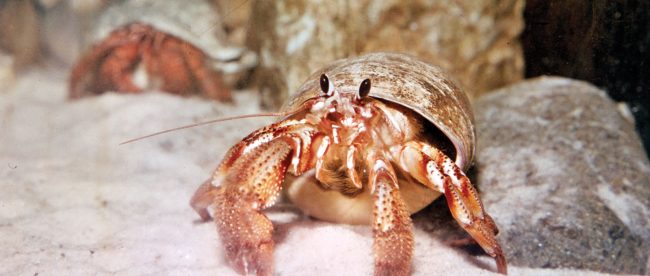Kindergarten Crabs?

Hermit crabs make for good classroom pets. They’re contained in tanks, making them easy to watch and hard to lose. They’re resilient — with a bunch of kindergarteners taking them home each weekend, that’s a requirement. And most importantly, hermit crabs don’t have natural exoskeletons to shield them from the sun and environment. Instead, they use shells as temporary homes; and when the crabs outgrow their shells, they find bigger ones. For kids, they can see watch this first-hand, learning about how animals grow in a very visual way.
In short, kids can learn a lot from hermit crabs.
Including how to line up.
When kindergarten kids need to leave the classroom, they often do so in single-file lines, intended mostly to make it easier for the teachers to get them from point A to point B. These single-file lines provide order in a transition that is otherwise orderly chaotic. And it turns out, in the wild, hermit crabs do something similar.
As the crabs grow, as noted above, they need to locate increasingly larger shells to use as homes (or maybe more accurately, as clothes, but whatever). That seems like a straightforward process: the crabs are probably walking up and down the beach anyway, so when one comes across a more suitable shell, it just gets out of the old and into the new, right? Well, not quite. It turns out that hermit crab shell searching isn’t a solo endeavor. Let’s took at the video below (also here), via the BBC.
For those who can’t see the video, a hermit crab in need of a new shell comes across one — but soon realizes that the, larger option is simply too large. Instead of leaving the area in search of something more suitable, though, it just kind of hangs out near the new shell. And then, other crabs come by to do the same. Sooner or later, a hermit crab that is large enough to move into the newly-discovered shell joins the group, and that’s when the magic happens. Discovery Magazine describes the next part of the process in a fun, straightforward way:
The hermit crabs form a sort of conga line ordered from largest to smallest crab. As the largest crab enters its new home, the next crab in line takes the vacated shell, leaving an open shell for the crab behind him. The shell swapping continues down the line until everyone has upgraded. This chain reaction is called a vacancy chain, and it’s an ingenious way for the creatures to survive while sharing limited resources.
The line isn’t as peaceful as a class of kindergarteners going off to the cafeteria, though. A few of the crabs, as you’d expect from wild animals, fight over the shells. And with no kindergarten teacher in sight, those who lose the battle are, at times, worse off than before the gathering.
Bonus fact: While pet hermit crabs rarely live more than a few months, that’s likely because classrooms full of five-year-olds aren’t great caretakers. According to Pet Smart, in the right conditions, hermit crabs have a lifespan of as long as 20 years.
From the Archives: Why Did the Crab Cross the Road?: To get to the beach.
